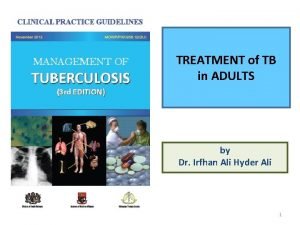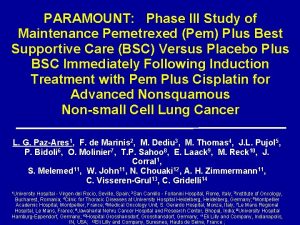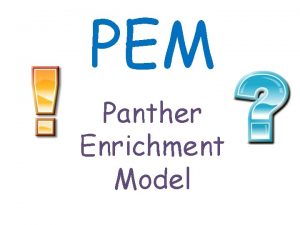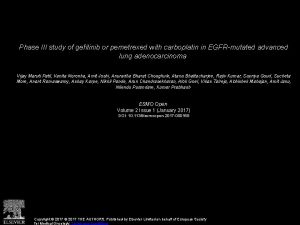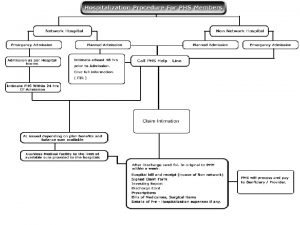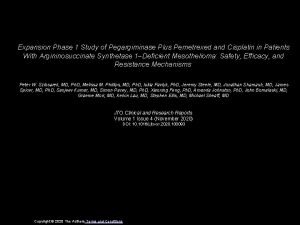PARAMOUNT Phase III Study of Maintenance Pemetrexed Pem








- Slides: 8

PARAMOUNT: Phase III Study of Maintenance Pemetrexed (Pem) plus Best Supportive Care (BSC) versus Placebo plus BSC Immediately Following Induction Treatment with Pem plus Cisplatin for Advanced Nonsquamous Non-Small Cell Lung Cancer Paz-Ares LG et al. Proc ASCO 2011; Abstract CRA 7510.

Maintenance Therapy: Continuation vs Switch • Continuation maintenance – Continual suppression of malignancy will be more effective than intermittent use • Switch maintenance (planned sequential) – Transition to proven second-line therapy before the emergence of resistance – Early use assures exposure to second-line therapy (ie, “no one falls off the cliff”) Edelman MJ. Proc ASCO 2011; Discussant.

PARAMOUNT Phase III Study of Pemetrexed Continuation Maintenance Patient Eligibility: • Nonsquamous NSCLC • No prior systemic therapy Continuation Maintenance (until PD) Induction Pem + BSC Pem + cisplatin d 1, q 21 days x 4 CR, PR SD R 2: 1 Continuation Maintenance (until PD) Placebo + BSC d 1, q 21 days Paz-Ares LG et al. Proc ASCO 2011; Abstract CRA 7510.

Progression-Free Survival (PFS) from Maintenance: Independent Review Median PFS* (months) Pem + BSC (n = 316) Placebo + BSC (n = 156) 3. 9 2. 6 Hazard ratio: 0. 64, p = 0. 0002 * 88% of patients were independently reviewed (472/539). Paz-Ares LG et al. Proc ASCO 2011; Abstract CRA 7510.

Tumor Response* from Maintenance Independent Review Pemetrexed (n = 316) Placebo (n = 156) p-value 9 (2. 8%) 1 (0. 6%) 0. 176 0 0 9 (2. 8%) 1 (0. 6%) Stable disease 218 (69. 0%) 92 (59. 0%) — Disease control rate 227 (71. 8%) 93 (59. 6%) 0. 009 Response rate Complete response Partial response *Response represents a further tumor reduction from the baseline response to induction therapy. Paz-Ares LG et al. Proc ASCO 2011; Abstract CRA 7510.

Select Grade 3 and 4 Drug-Related Toxicities Pemetrexed (n = 359) Placebo (n = 180) Fatigue* 4. 2% 0. 6% Anemia* 4. 5% 0. 6% Neutropenia* 3. 6% 0 Leukopenia 1. 7% 0 Sensory neuropathy 0. 3% 0. 6% Mucositis/stomatitis 0. 3% 0 ALT (SGPT) 0. 3% 0 Adverse event * Statistically significant between arms (p ≤ 0. 05) Paz-Ares LG et al. Proc ASCO 2011; Abstract CRA 7510.

Conclusions • The trial met its primary PFS endpoint as pemetrexed maintenance therapy resulted in a significant benefit compared to placebo for patients with advanced nonsquamous NSCLC (3. 9 mo vs 2. 6 mo; HR = 0. 64). • Pemetrexed maintenance was well tolerated. • Mature OS data are pending. Paz-Ares LG et al. Proc ASCO 2011; Abstract CRA 7510.

Investigator Commentary: Continuation Maintenance with Pemetrexed for Advanced Nonsquamous NSCLC The main question of the PARAMOUNT trial was how effective would continuation maintenance be with pemetrexed. The progression-free survival results were consistent with their previous reports. Although they remained statistically significant, they were not as dramatic. I believe these results can be used by community oncologists as validation that you can start with a pemetrexed-based doublet with platinum up front and then continue the pemetrexed as maintenance. Some will argue that continuation maintenance is not as effective as switch maintenance, and this is a topic that will remain debatable in the future. The important message from PARAMOUNT is that pemetrexed maintenance is safe to administer and the PFS benefit is maintained. It is an acceptable standard in addition to other regimens that clinicians use to treat patients. I personally was not a big believer in maintenance therapy, but I do use it now. Continuing to treat a patient with a therapeutic agent seems to help. Edward S Kim, MD



